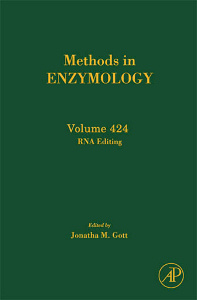Description
RNA Editing
Author: GOTT Jonatha
Language: English
Subjects for RNA Editing:
Publication date: 09-2007
592 p. · 15x22.8 cm · Hardback
592 p. · 15x22.8 cm · Hardback
Description
/li>Contents
/li>Readership
/li>Comment
/li>
RNA processing plays a critical role in realizing the full potential of a given genome. One means of achieving protein diversity is through RNA editing. A diverse array of editing events has been characterized, affecting gene expression in organisms from viruses and single cell parasites to humans and plants. The variety of editing mechanisms has required the development of many different experimental approaches, many of which are likely to be broadly applicable, particularly given the interplay between editing and other cellular processes, including transcription, splicing, and RNA silencing. RNA Editing not only covers most of the principal methods employed in the field, but also offers innovative solutions to the significant challenges posed by these experimental systems.
Trypanosome U insertion/deletion.
Chapter 1: Isolation and Compositional Analysis of Trypanosomatid Editosomes.
Chapter 2: U insertion/deletion editing activities.
Chapter 3: RNA Editing Uridylyltransferases of Trypanosomes.
Chapter 4: Isolation of RNA binding proteins involved in insertion/deletion editing
Chapter 5: RNA-protein Interactions in Assembled Editing Complexes in Trypanosomes.
Chapter 6: Strategies of Kinetoplastid Cryptogene Discovery and Analysis.
Physarum insertion editing.
Chapter 7: RNA editing in Physarum mitochondria: assays and biochemical approaches.
Chapter 8: Computational approaches to insertional RNA editing.
Chapter 9: Evolution of RNA Editing Sites in the Mitochondrial Small Subunit rRNA of the Myxomycota.
5' deletion/insertion editing of tRNAs.
Chapter 10: Analysis of 5´- or 3´-Terminal tRNA Editing: Mitochondrial 5´ tRNA Editing in Acanthamoeba castellanii as the Exemplar.
A to I editing.
Chapter 11: Comparative genomic and bioinformatic approaches for the identification of new adenosine to inosine substrates.
Chapter 12: Genetic approaches to studing adenosine to inosine RNA editing.
Chapter 13: A method to find sites of selective adenosine deamination.
Chapter 14 : Purification and assay of ADAR activity.
Chapter 15: Large Scale Overexpression and Purification of ADARs from S. cerevisiae for Biophysical and Biochemical Studies.
Chapter 16: Mouse models to elucidate the functional roles of A-to-I editing.
Chapter 17: Probing Adenosine to Inosine Editing Reactions using RNA containing Nucleoside Analogs.
Nuclear C to U editing.
Chapter 18: Measuring Editing Activity and Identifying C to U mRNA Editing Factors in Cells and Biochemical Isolates.
Chapter 19: Mouse Models as Tools to Explore C to U RNA Editing.
Editing in plant organelles
Chapter 20: RNA editing in plant mitochondria: assays and biochemical approaches.
Chapter 21: Assay of Editing of Exogenous RNAs in Chloroplast Extracts of Arabidopsis, Maize, Pea, and Tobacco.
Chapter 22: In organello gene expression and RNA editing studies by electroporation-mediated transformation of isolated plant mitochondria.
Chapter 23: Transformation of the Plastid Genome to Study RNA Editing.
Chapter 1: Isolation and Compositional Analysis of Trypanosomatid Editosomes.
Chapter 2: U insertion/deletion editing activities.
Chapter 3: RNA Editing Uridylyltransferases of Trypanosomes.
Chapter 4: Isolation of RNA binding proteins involved in insertion/deletion editing
Chapter 5: RNA-protein Interactions in Assembled Editing Complexes in Trypanosomes.
Chapter 6: Strategies of Kinetoplastid Cryptogene Discovery and Analysis.
Physarum insertion editing.
Chapter 7: RNA editing in Physarum mitochondria: assays and biochemical approaches.
Chapter 8: Computational approaches to insertional RNA editing.
Chapter 9: Evolution of RNA Editing Sites in the Mitochondrial Small Subunit rRNA of the Myxomycota.
5' deletion/insertion editing of tRNAs.
Chapter 10: Analysis of 5´- or 3´-Terminal tRNA Editing: Mitochondrial 5´ tRNA Editing in Acanthamoeba castellanii as the Exemplar.
A to I editing.
Chapter 11: Comparative genomic and bioinformatic approaches for the identification of new adenosine to inosine substrates.
Chapter 12: Genetic approaches to studing adenosine to inosine RNA editing.
Chapter 13: A method to find sites of selective adenosine deamination.
Chapter 14 : Purification and assay of ADAR activity.
Chapter 15: Large Scale Overexpression and Purification of ADARs from S. cerevisiae for Biophysical and Biochemical Studies.
Chapter 16: Mouse models to elucidate the functional roles of A-to-I editing.
Chapter 17: Probing Adenosine to Inosine Editing Reactions using RNA containing Nucleoside Analogs.
Nuclear C to U editing.
Chapter 18: Measuring Editing Activity and Identifying C to U mRNA Editing Factors in Cells and Biochemical Isolates.
Chapter 19: Mouse Models as Tools to Explore C to U RNA Editing.
Editing in plant organelles
Chapter 20: RNA editing in plant mitochondria: assays and biochemical approaches.
Chapter 21: Assay of Editing of Exogenous RNAs in Chloroplast Extracts of Arabidopsis, Maize, Pea, and Tobacco.
Chapter 22: In organello gene expression and RNA editing studies by electroporation-mediated transformation of isolated plant mitochondria.
Chapter 23: Transformation of the Plastid Genome to Study RNA Editing.
Biochemists, molecular biologists, computational and systems biologists, plant biologists, and molecular parasitologists working in the fields of RNA editing and modification.
- Presents newly developed methods
- Covers topics ranging from biochemistry to bioinformatics
- Includes innovative solutions to potential problems
© 2024 LAVOISIER S.A.S.
These books may interest you

Pre-mRNA Processing 52.74 €



